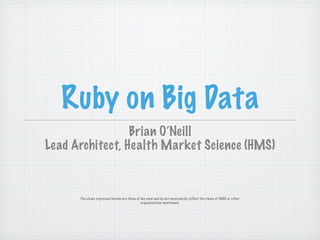Ruby on Big Data (Cassandra + Hadoop)
- 1. Ruby on Big Data Brian O’Neill Lead Architect, Health Market Science (HMS) The views expressed herein are those of my own and do not necessarily reflect the views of HMS or other organizations mentioned.
- 2. Agenda Big Data Orientation Cassandra Hadoop SOLR Storm DEMO Java/Ruby Interoperability Advanced Ideas Rails Integration Combing Real-time w/ Batch Processing (The Final Frontier)
- 3. “Big” Data Size doesn’t always matter, it may be what your doing with it e.g. Natural-Language Processing Flexibility was our major motivator Data sources with disparate schema
- 4. Decomposing the Problem Data Processing Storage Distributed Indexing Batch Querying Real-time
- 5. Relational Storage ACID Atomic: Everything in a transaction succeeds or the entire transaction is rolled back. Consistent: A transaction cannot leave the database in an inconsistent state. Isolated: Transactions cannot interfere with each other. Durable: Completed transactions persist, even when ser vers restart etc.
- 6. Relational Storage Benefits Limitations Data Integrity Static Schemas Ubiquity Scalability
- 7. NoSQL Storage BASE Basic Availability Soft-state Eventual consistency Simple API REST + JSON
- 8. Indexing Real-time Answers Full-text queries Fuzzy Searching Nickname analysis Geospatial and Temporal Search
- 10. Indexing Options
- 11. Why? Cassandra Consistency-level per operation Temporal dimension of an operation Idempotent mentality SOLR Community Integration (Solandra) NOT scalability and flexibility (sharding stinks)
- 12. Cassandra’s Data Model Keyspaces Column Families Rows (Sorted by KEY!) Columns (Name : Value)
- 13. Example BeerGuys (Keyspace) Users (Column Families) bonedog (Row) firstName : Brian lastName : O’Neill lisa (Row) firstName : Lisa lastName : O’Neill maidenName : Kelley
- 14. Cassandra Architecture Ring Architecture A (N-Z) Hash(key) -> Node Reliability F (A-F) Scalability Client M (G-M)
- 15. Why NoSQL for us? Flexibility A new data processing paradigm Instead of: Data Processing Do this: Processing Data
- 16. Batch Processing DATA JOB A Distributable (T-A) Scalable Data Locality S HDFS H (I-R) (B-G)
- 17. Map / Reduce tuple = (key, value) map(x) -> tuple[] reduce(key, value[]) -> tuple[]
- 18. Word Count The Code The Run def map(doc) doc1 = “boy meets girl” doc.each do |word| doc2 = ”girl likes boy”) emit(word, 1) map (doc1) -> (boy, 1), (meets, 1), (girl, 1) end map (doc2) -> (girl, 1), (likes, 1), (boy, 1) end reduce (boy, [1, 1]) -> (boy, 2) def reduce(key, values[]) reduce (girl, [1, 1]) -> (girl, 2) sum = values.inject {|sum,x| sum + x } reduce (likes [1]) -> (likes, 1) emit(key, sum) reduce (meets, [1]) -> (meets, 1) end
- 19. Queries / Flows Hive Pig Cascading
- 20. Real-time Processing Deals with data streams Storm tuple Bolt tuple Spout Bolt tuple tuple tuple Bolt Spout Bolt tuple tuple Bolt
- 21. Putting it Together A (T-A) S Storm H (I-R) (B-G)
- 22. But... We love Ruby! and it’s all in Java. :( That’s okay, because We love REST!
- 23. REST Layer CRUD via HTTP Map/Reduce via HTTP A Client S H Storm
- 24. DEMO
- 25. Java Interoperability Conventional Interoperability I/O Streams bet ween processes Hadoop Streaming Storm Multilang
- 26. CRUD via HTTP http://virgil/data/{keyspace}/{columnFamily}/{column}/{row} PUT : Replaces Content of Row/Column GET : Retrieves Value of a Row/Column DELETE : Removes Value of a Row/Column A curl S H
- 27. Map/Reduce over HTTP wordcount.rb def map(rowKey, columns) result = [] columns.each do |column_name, value| words = value.split A words.each do |word| result << [word, "1"] end end curl return result end def reduce(key, values) rows = {} total = 0 S H columns = {} values.each do |value| total += value.to_i end columns["count"] = total.to_s rows[key] = columns return rows end CF in CF out
- 28. Better? Use JRuby Single Process Parse Once / Eval Many JSR 223 ScriptEngine ENGINE = new ScriptEngineManager().getEngineByName("jruby"); ScriptContext context = new SimpleScriptContext(); Bindings bindings = context.getBindings(ScriptContext.ENGINE_SCOPE); bindings.put("variable", "value"); ENGINE.eval(script, context); Redbridge this.rubyContainer = new ScriptingContainer(LocalContextScope.CONCURRENT); this.rubyReceiver = rubyContainer.runScriptlet(script); container.callMethod(rubyReceiver, "foo", "value");
- 29. Rails Integration A Balancer Load ta Da g S H sin es oc Pr “REST is the new JDBC” ActiveRecord backed by REST? Anything more than a proxy?
- 30. Ratch Processing (Combing Real-time and Batch) Data Flows as: Cascading Map/Reduce jobs Storm Topologies? Can’t we have one framework to rule them all?
Editor's Notes
- \n
- \n
- \n
- \n
- \n
- \n
- \n
- \n
- \n
- \n
- \n
- \n
- \n
- \n
- \n
- \n
- \n
- \n
- \n
- \n
- \n
- \n
- \n
- \n
- \n
- \n
- \n
- \n
- \n
- \n

